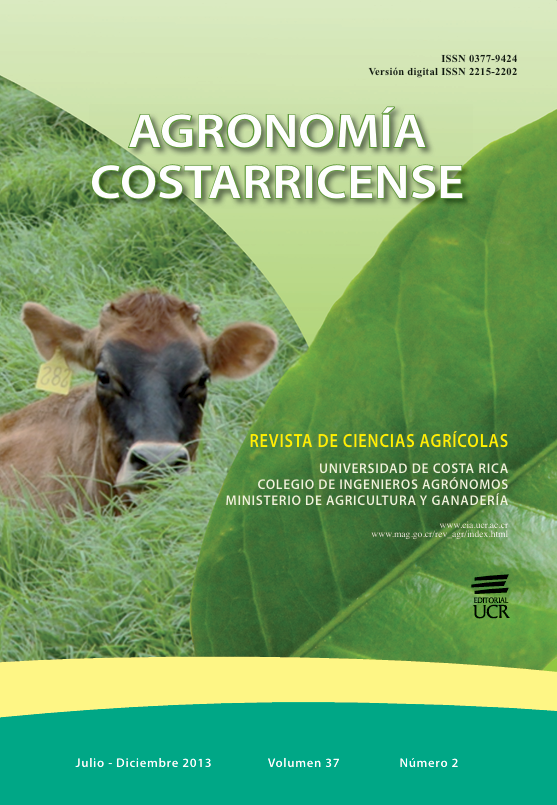Abstract
Leaf cutting ants (Atta spp.) can destroy complete plantations of economically important crops in Tropical and Subtropical America, by cutting plant tissues and transporting them to underground nests where they grow a fungus of the Basediomycota Phylum which is their main food resource. At present, no effective management strategy for this pest is available. Most of the products in the market are poorly effective, are residual in the environment and have a high price. The present investigation evaluated different ingredients used in granular preparation that have been reported as carried away by ants, with potential of being incorporated as active ingredients against the leaf cutting ants’ symbiotic fungus. Granules with different combinations and concentrations of inert ingredients were prepared, using citrus pulp, alcoholic extracts of orange peel and seeds as attractants. In order to verify the compatibility of the base formulations with the active ingredients, Azadirachta indica (neem), Trichoderma spp., and yeasts were used in different concentrations. Granule characteristics were evaluated as indicators of viability and stability of formulates. Baits formulated with citrus pulp were capable of keeping a stable acidity, and also to conserve Trichoderma spp., and yeasts viability for a longer period than formulates containing alcoholic extract of orange peel used as an attractant. Also, granules with a citrus pulp base had a lower production cost. It was concluded that citrus pulp is an appropriate base for the incorporation of active ingredients with biologic effect against the symbiotic fungi and has potential as a base for commercial production.References
ARANGO J., SINIGUI A. 2008. Manejo de la sanidad vegetal en el bosque tropical húmedo: el caso de las hormigas arrieras en Chageradó. Revista de Agroecología, LEISA, Marzo, p. 28-31.
ATSDR (Agencia para Sustancias Tóxicas y el Registro de Enfermedades IT). 1995. Reseña Toxicológica del Mirex y la Clordecona. Departamento de Salud y Servicios Humanos de Estados Unidos. Consultado 5 diciembre 2008. Disponible en http://www.atsdr.cdc.gov/es/toxfaqs/es_tfacts66.html
BOARETTO M., FORTI L. 1997. Perspectivas no controle de formigas cortadeiras. Departamento de Defesa Fitossanitária da FCA/UNESP. Série técnica IPEF. 11(30):31-46.
BOARETTO M., FORTI L., LOPES J., NAGAMOTO N., DE ANDRADE A., MOREIRA A., VIANA A., RAMOS V. 2003. Response of the grass-cutting ant Atta capiguara gonçalves, 1944 (Hymenoptera: Formicidae) to sugars and artificial sweeteners. Scientia Agricola 60(3):505-509.
CAFFARINI P., CARRIZO P., PELICANO A. 2006. Extractos cítricos como atrayentes para cebos hormiguicidas con sustancias naturales. Revista Facultad de Ciencias Agrícolas UNCuyo 38(1):19-26.
CAFFARINI P., CARRIZO P., PELICANO A., ROGGERO P., PACHECO P. 2008. Efectos de extractos acetónicos y acuosos de Ricinus communis (ricino), Meliaazedarach (paraíso) y Trichillia glauca (trichillia), sobre la hormiga negra común (Acromyrmex lundi), IDESIA, 26(1):59-64.
CHAPELA I., REHNER S., SCHULTZ T., MUELLER U. 1994. Evolutionary history of the symbiosis between fungus growing ants and their fungi. Science 266:1691–1695.
DELABIE J., DELLA L., PASTRE L. 2000. Protocolo de experimentação para avaliar a atratividade de novas formulações de iscas granuladas utilizadas no controle das formigas cortadeiras Acromyrmex spp., e Atta spp. (Hymenoptera: Formicidae: Myrmicinae: Attini) no Campo Brasil. An. Soc. Entomol. Brasil 29(4):843-848.
DI RIENZO J., CASANOVES F., BALZARINI M., GONZÁLEZ L., TABLADA M., ROBLEDO C. 2009. InfoStat versión 2009. Grupo InfoStat, FCA, Universidad Nacional de Córdoba, Argentina.
GRUBER A., VALDIX J. 2003. Control de Atta spp., con prácticas agrícolas e insecticidas botánicos. Manejo Integrado de Plagas y Agroecología 67:87-90.
HINKLE G., WETTERER J., SCHULTZ T., SOGIN M. 1994. Phylogeny of the attine fungi based on analysis of small subunit ribosomal RNA gene sequences. Science 266:1695–97.
HÖLLDOBLER B., WILSON E. 1999. The ants. The Belknap press of Harvard University Press, Cambridge, Massachussetts. 732 p.
KUMAR H., PATOLE M., SHOUCHE Y. 2006. Fungal farming: a story of four partner evolution. Current Science 90(11):1463-1464.
LÓPEZ E., ORDUZ S. 2003. Metarhizium anisopliae y Trichoderma viride controlan colonias de Atta cephalotes en campo mejor que un insecticida químico. Unidad de Biotecnología y Control Biológico, Corporación para Investigaciones Biológicas-CIB, Medellín, Colombia. Consultado 23 noviembre 2008. Disponible en http://www.revistas.unal.edu.co/index.php/biotecnologia/article/viewFile/30093/30287
MAZARIEGOS L.A. 2003. Production of biopesticides by the columbian company Laverlam, pp. 111-115. In: U. Roettger and R. Muschler (eds.). International symposium on biopesticides for developing countries (2003: Turrialba, Costa Rica). PAN, GTZ, CATIE.
NACCARATA V., JAFFE K. 1989. Formulación y desarrollo de un cebo atractivo tóxico para control de bachacos, Atta spp. (Hymenoptera: Formicidae) en Venezuela. Boletín de Entomología de Venezuela 5(11):81-88.
OMS-FAO (Organización Mundial de la Salud-Organización de las Naciones Unidas para la Agricultura y la Alimentación IT). 2004. Manual sobre elaboración y empleo de las especificaciones de la FAO y de la OMS para plaguicidas, FAO, IT. 271 p.
ORTIZ A., ORDUZ S. 2000. In vitro evaluation of Trichoderma and Gliocladium antagonism against the symbiotic fungus of the leaf-cutting ant Atta cephalotes. Mycopathologia 150:53-60.
PALACIOS F., GLADSTONE S. 2003. Eficacia del farnesol y de un extracto de semilla de ayote como repelentes de Atta mexicana. Manejo Integrado de Plagas y Agroecología 68:89-91.
PARIONA N., CASTELLANOS P., LEÓN E. 2007. Capacidad entomocida de cepas nativas de Beauveria sp., sobre Schistocerca piceifrons peruviana (Lynch Arribalzaga 1903). Revista Peruana de Biología 14(2):253-257.
PÉREZ R. 1947. El problema de las hormigas del género Atta Fabr., en la América. Tesis de maestría, Instituto Interamericano de Ciencias Agrícolas, Turrialba, Costa Rica. 74 p.
RICCI M., BENÍTEZ D., PADIN S., MACEIRAS A. 2005. Hormigas argentinas: comportamiento, distribución y control. Facultad de Ciencias Agrarias y Forestales. Universidad Nacional de La Plata, Argentina. 27 p.
VARÓN E. 2006. Distribution and foraging by the leafcutting ant, Atta cephalotes L., in coffee plantations with different types of management and landscape contexts, and alternatives to insecticides for its control. Tesis PhD, University of Idaho, Idaho, US. 145 p.
VERZA S., FORTI L., MATOS C., GARCIA M., NAGAMOTO N. 2006. Attractiveness of citrus pulp and orange albedo extracts to Atta sexdens rubropilosa (Hymenoptera: Formicidae). Sociobiology 47(2):391-399.


